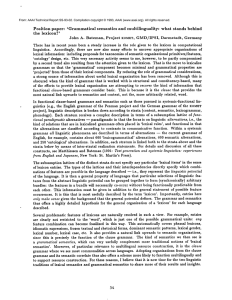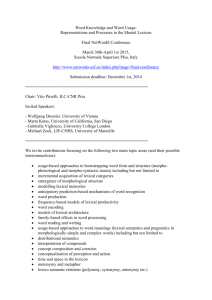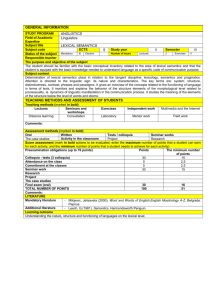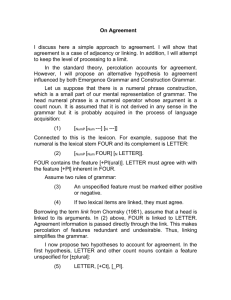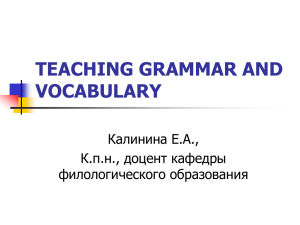Chapter 1: Introduction
advertisement
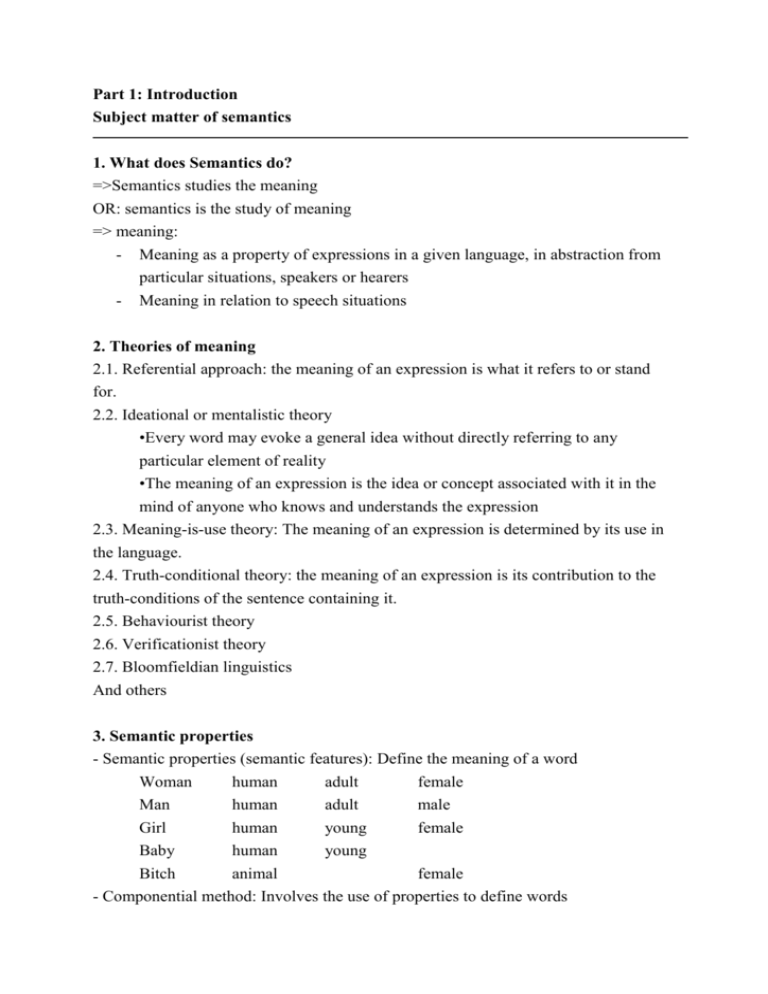
Part 1: Introduction Subject matter of semantics 1. What does Semantics do? =>Semantics studies the meaning OR: semantics is the study of meaning => meaning: - Meaning as a property of expressions in a given language, in abstraction from particular situations, speakers or hearers - Meaning in relation to speech situations 2. Theories of meaning 2.1. Referential approach: the meaning of an expression is what it refers to or stand for. 2.2. Ideational or mentalistic theory •Every word may evoke a general idea without directly referring to any particular element of reality •The meaning of an expression is the idea or concept associated with it in the mind of anyone who knows and understands the expression 2.3. Meaning-is-use theory: The meaning of an expression is determined by its use in the language. 2.4. Truth-conditional theory: the meaning of an expression is its contribution to the truth-conditions of the sentence containing it. 2.5. Behaviourist theory 2.6. Verificationist theory 2.7. Bloomfieldian linguistics And others 3. Semantic properties - Semantic properties (semantic features): Define the meaning of a word Woman human adult female Man human adult male Girl human young female Baby human young Bitch animal female - Componential method: Involves the use of properties to define words Example: PROPERTY GIRL WOMAN MAN BABY BITCH Human + + + + - Female + + - Young + - - + + - 4. Components of word-meaning 4.1. Denotation: - Conceptual meaning: based on two structural principles: contrastiveness and constituent structure. These two principles represent the way language is organized on what linguists have termed the Praradigmatic (selectional) and Syntagmatic (combinatory) axes of linguistic structure. E.g: woman: +human, -male, + adult as distinct from boy: +human, +male, -adult - Referential meaning: the meaning of an expression is what it refers to, or denotes, or stand for. E.g.: table: refers to either the general class of tables or the essential property which they all share. 4.2. Connotation: - Stylistic: is the communicative value an expression has by virtue of what it refers to, over and above its purely conceptual content. E.g.: dialects: African English, Singlish, baby language (da da, gee-gee) Time: language of the 18th century, whilst, amidst, thee, thy, dieth Province: the language of law, poetry, etc Status (polite, casual, colloquial, slang): cop, loo (WC), kick the bucket Modality (language of lectures, jokes) Individuality (the language of Mr. X, of Mrs. Y) etc - Affective: What is communicated of the feelings and attitudes of speaker/writer. It is often conveyed through conceptual or connotative content of the words used. Factors such as intonation, voice, tone, etc are also important. E.g.: I’m terribly sorry to interrupt but …/ Alas/ Hoorey/ Viva/ - Evaluative: notorious (well known for bad things) vs. celebrated (well known for good things) - Intensifying: terribly, deadly, extremely 4.3. Structural/associative meaning - Reflected meaning: what is communicated through association with another sense of the same expression: intercourse, ejection, “tươi mát”, - Collocative meaning: what is communicated through association with words which tend to occur in the environment of another word. E.g.: - pretty boy/ girl/ woman/ flower/ garden/ colour Handsome boy/ man/ car/ overcoat/ airliner/ typewriter Associative meaning: is the meaning which arises because of its association with other meaningL good vs. bad, buy vs. sell - Thematic meaning: is the meaning which is communicated by the way in which a speaker or writer organizes the message in terms of ordering, focus and emphasis e.g.: The dog chased the cat # the cat was chased by the dog. 4.4. Categorial meaning: verbs, nouns, adjectives, etc 5. Lexical meaning and grammatical meaning: - Lexical meaning: meaning of lexicon - Grammatical meaning: meaning studied in grammar - Grammar: a system of rules which says about how lexical items are put together to form phrases, clauses, sentences… (tense, mood, aspect, voice, number, person, comparison…) E.g: - Love, take, work, laugh: same or different ? different: lexical meaning Same: grammatical meaning (verbs) - Boy-boys ? Same: lexical meaning Different: grammatical meaning (number) - Empty words: syntactic function - Full words: lexical meaning - Grammar and lexicon interrelated: + The grammar reflects the ways in which the lexicon operates as means of communication and as instrument of thoughts + Part of the meaning of the lexicon is encoded in the grammatical structure of languages Want – wanted tense Nicer – nicer comparison Coffee! – Coffee? Know – known mood aspect Man – men number 6. Sentence meaning and lexical meaning: • Sentence meaning: language side • - Determined partly by meanings of the words comprising it and partly by its grammatical structure - Highly context-independent Utterance meaning: - • realization of the sentence What speaker means when he makes an utterance in a certain situation -> context-dependent Speech acts: » » » Locutionary act : actual form of utterance Illocutionary act : Communicative force of the Utterance Perlocutionary act: Communicative effect of the utterance Example: It’s hot in here. » Locution: act of producing the utterance “it’s hot in here” » Illocution: An indirect request “Open the door” or ‘Turn the A-C on” » Perlocution: Effect: the hearer turned the electronic fan on



